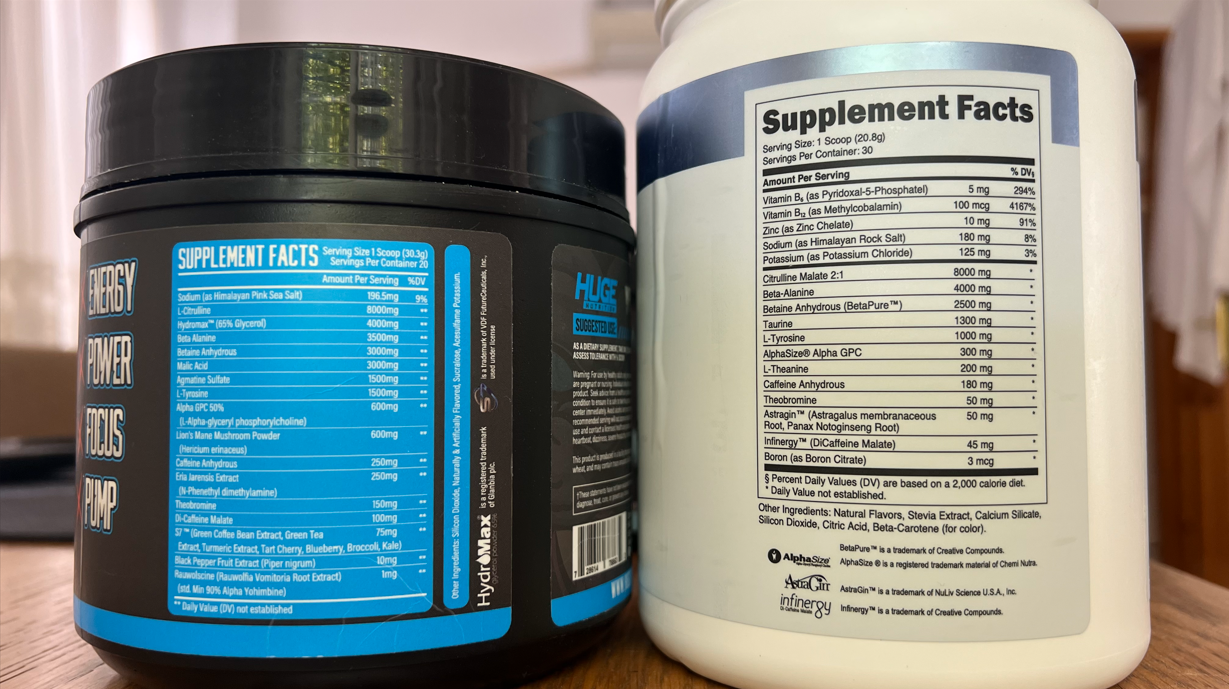
In the world of stimulants and energy boosters, caffeine reigns supreme.
But did you know there are different forms of caffeine, each with its unique characteristics?
Two of the most common forms found in supplements are caffeine anhydrous and caffeine malate.
While they both provide the energy-boosting effects of caffeine, the way they deliver this energy differs significantly.
Let's dive into the world of caffeine and explore these two forms in detail.
Caffeine anhydrous provides a quick, immediate energy boost, while caffeine malate offers a more gradual, sustained energy release due to the buffering effect of malic acid.
Caffeine malate is a compound made by fusing caffeine and malic acid.
This unique combination is designed to provide all the benefits of caffeine but with fewer side effects.
Adding malic acid is said to help buffer the harsh effects of caffeine, leading to a smoother, crash-free energy boost.
Plus, malic acid plays a key role in energy production in the body, potentially enhancing the energy-boosting effects of caffeine.
Find a pre-workout with specific amounts of caffeine here.

When it comes to comparing caffeine and caffeine malate, it's important to consider several factors.
These include their effects on energy, focus, athletic performance, and potential side effects.
Let's take a closer look at how these two stack up.
Both caffeine and caffeine malate are known for their ability to boost energy.
However, caffeine malate is often described as providing a smoother, longer-lasting energy boost without the harsh 'crash' that can come with regular caffeine.
This is likely due to the addition of malic acid, which helps buffer the effects of caffeine and supports energy production in the body.
Caffeine is well-known for its ability to enhance focus and cognitive function.
Caffeine malate is believed to offer similar benefits, but with the added advantage of a smoother, crash-free experience.
This could make it a better choice for tasks that require sustained focus and attention.
You might like: Best Nootropic Pre-Workouts
Caffeine has been shown to enhance athletic performance in various ways, including improving endurance, reducing perceived effort, and boosting strength and power.
While research on caffeine malate's effects on athletic performance is limited, its smoother, longer-lasting energy boost could potentially make it a valuable tool for athletes.
While caffeine is generally safe for most people, it can cause side effects like jitters, restlessness, and a post-caffeine 'crash'.
Caffeine malate is designed to provide the benefits of caffeine with fewer side effects, thanks to the addition of malic acid.
With the speed of action, caffeine anhydrous and caffeine malate have unique characteristics.
Caffeine anhydrous, the dehydrated form of caffeine, is known for its rapid absorption and quick energy-boosting effects.
It gets into your bloodstream quickly and starts working its magic, providing you with an immediate surge of energy.
This makes it a popular choice for those who need an instant pick-me-up, like before a high-intensity workout or a demanding mental task.
However, this quick energy boost comes with a downside.
The effects of caffeine anhydrous tend to wear off relatively quickly, leading to an energy crash.
This sudden drop in energy levels can leave you feeling tired and sluggish, which is not ideal, especially if you're in the middle of a workout or a task that requires sustained energy and focus.
On the other hand, caffeine malate, also known as di-caffeine malate or Infinergy, offers a more gradual and sustained energy release.
This patented form of caffeine is a compound of caffeine and malic acid.
It's designed to provide the stimulatory benefits of caffeine, but with a smoother, longer-lasting effect.
The malic acid in caffeine malate acts as a buffer to the caffeine, allowing it to be released and absorbed more slowly.
This results in a steady stream of energy that lasts longer without the sudden crash associated with caffeine anhydrous.
This makes caffeine malate an excellent choice for activities that require sustained energy and focus over a longer period.
It's also a popular ingredient in pre-workout supplements, fat burners, and nootropics for its long-lasting energy and focus-enhancing effects.
However, individual responses can vary, and some people may still experience side effects.

In many supplements, caffeine, anhydrous, and malate are used together.
This combination offers the best of both worlds: the immediate energy boost from caffeine anhydrous and the sustained energy release from caffeine malate.
This way, you get a quick surge of energy to kick-start your workout or task, followed by a steady stream of energy to keep you going.
It's important to note that everyone's tolerance to caffeine varies, so the effects may differ from person to person.
Always start with a lower dose to assess your tolerance and avoid potential side effects like anxiety, digestive issues, and rapid heartbeat.
While caffeine can provide a temporary energy boost, it's not a substitute for a balanced diet, regular exercise, and adequate sleep.
Always use caffeine responsibly and as part of a healthy lifestyle.
This study provides more insights into the effects of caffeine on exercise performance.
Another study discusses the potential benefits and risks of caffeine use in sports.
For more information on the safety and potential side effects of caffeine, this review provides a comprehensive overview.
When it comes to the duration of effects, caffeine and caffeine malate differ significantly.
Caffeine, a well-known stimulant, is quickly absorbed into the bloodstream.
It reaches peak levels within 30 to 60 minutes of consumption.
This is when you're most likely to experience caffeine's "jittery" effects.
The half-life of caffeine is about 5 hours.
This is the time it takes for the body to eliminate half of the drug.
So, if you consume 40 milligrams (mg) of caffeine, you will have 20 mg remaining in your system after 5 hours.
However, the effects of caffeine can last up to 8 hours.
Many experts recommend avoiding caffeine within eight hours of sleep to ensure it does not interfere with sleep.
On the other hand, caffeine malate is a compound made by fusing caffeine and malic acid.
Approximately 75% of caffeine malate is caffeine, and the remaining 25% is malic acid.
This combination is believed to provide a smoother, longer-lasting energy boost than regular caffeine.
While there's less research on the exact duration of caffeine malate's effects, it's generally believed to provide sustained energy release, reducing the "crash" associated with regular caffeine.
In conclusion, while both caffeine and caffeine malate can provide a boost of energy, they differ in their duration and quality of effects.
Caffeine provides a quick, intense energy boost lasting for several hours, while caffeine malate offers a smoother, potentially longer-lasting energy increase.
However, individual responses can vary, and it's important to consider personal tolerance and sensitivity when consuming these substances.
While caffeine and caffeine malate can boost energy, focus, and athletic performance, caffeine malate's smoother, crash-free energy boost could make it a better choice for some people.
Combining both can lead to some nice energy that lasts for hours without a crash.
However, more research is needed to understand this compound's potential benefits and drawbacks fully.
Recommended resource: The Comprehensive Guide to Pre-Workouts
What is the difference between caffeine anhydrous and caffeine malate?
Caffeine anhydrous is the dehydrated form of caffeine that provides a quick energy boost. Caffeine malate, on the other hand, is a compound of caffeine and malic acid that offers a more gradual and sustained energy release.
Why do some supplements use both caffeine anhydrous and caffeine malate?
Some supplements use both forms of caffeine to provide both benefits: the immediate energy boost from caffeine anhydrous and the sustained energy release from caffeine malate.
What are the potential side effects of caffeine?
Potential side effects of caffeine include anxiety, digestive issues, insomnia, high blood pressure, and rapid heartbeat. It's important to use caffeine responsibly and start with a lower dose to assess your tolerance.
Can I use caffeine instead of a balanced diet and regular exercise?
No, caffeine is not a substitute for a balanced diet, regular exercise, and adequate sleep. It can provide a temporary energy boost, but it should be used as part of a healthy lifestyle.
How much caffeine is safe to consume in a day?
The FDA recommends a maximum daily intake of 400mg of caffeine for most adults. However, everyone's tolerance to caffeine varies, so it's important to listen to your body and adjust your intake accordingly.
Caffeine anhydrous and caffeine malate both offer unique benefits when it comes to energy provision.
While caffeine anhydrous provides a quick energy boost, caffeine malate offers a more sustained energy release.
Many supplements use a combination of both to provide immediate and long-lasting energy.
However, it's important to use caffeine responsibly and as part of a healthy lifestyle, considering potential side effects and individual tolerance.
Useful Links
 About FitFrek
About FitFrekFitFrek operates as an independent platform, offering comprehensive workouts, programs, routines, guides, and unbiased reviews to accelerate your progress. We pride ourselves on our honesty, delivering straightforward and candid insights. FitFrek does not offer medical advice, diagnosis, or treatment services.